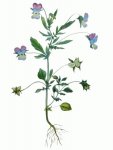Violet tri-color (pansies, ivan-da-marya)
Viola tricolor L.
Botanical characteristics. The family is violet. Biennial or annual herbaceous plant with thin branched, hollow, trihedral stems up to 20 cm high. Leaves alternate, round-heart-shaped, petiolate or sessile. Beautiful single flowers with multi-colored petals (violet, yellow, white) on long pedicels are located in the axils of the leaves. Blooms from April to autumn. Fruit - a box, ripened seeds are thrown out of it with force.
Spread. Medicinal properties have two types of violets - tricolor and field. It occurs in meadows, fields, on forest edges in the European part of Russia, in Siberia and in the Urals.
Used parts of the plant.
The aerial part of the plant (grass).
In the grass, ascorbic acid, salicylic acid (0.037%), mucus (9.5%), ursolic acid, carotenoids, flavonoids (vitexin, isovitine, orientite, isoeryentin, viopantine, vycetin-2, etc.), rutin. The flowers contain essential oil and anthocyanin glycosides (violanin, 3-glycoside of delphinidin and 3-glycoside of peonidine), in the roots are found in a small amount of alkaloids.
Application. In folk medicine used for neuroses, palpitation, insomnia. It is prescribed for inflammatory diseases of the upper respiratory tract and lungs - as a good expectorant. Violet is a necessary component in the collections used to treat diseases of the urinary tract, because it acts diuretically and anti-inflammatory. Grass is considered a sweatshop and a blood cleanser; Is prescribed for diseases of the joints, various skin diseases (furunculosis, acne). Outer is widely used for baths in the treatment of joints, skin diseases.
Contraindications. Glomerulonephritis, hepatitis.
Preparation.
1-2 tablespoons are brewed in a thermos bottle with 500 grams of boiling water - a daily dose. Another infusion (10,0: 200,0) - apply 1 tablespoon 3 times a day.
In homeopathy apply Viola 3x, 3 for allergic diseases, eczema and neurodermatitis. A characteristic symptom: a rash on the scalp and behind the ears, from which the liquid oozes; The patient sharply smelling urine, reminiscent of the smell of a cat.




Comments
When commenting on, remember that the content and tone of your message can hurt the feelings of real people, show respect and tolerance to your interlocutors even if you do not share their opinion, your behavior in the conditions of freedom of expression and anonymity provided by the Internet, changes Not only virtual, but also the real world. All comments are hidden from the index, spam is controlled.